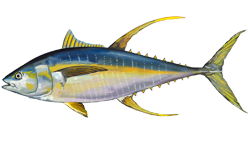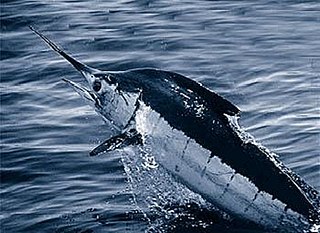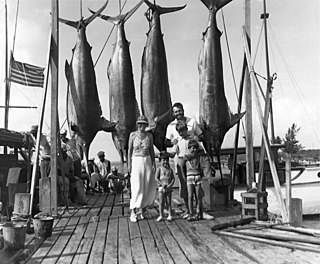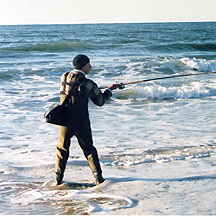
Big-game fishing, also known as offshore sportfishing, offshore gamefishing or blue-water fishing, is a form of recreational fishing targeting large game fish, usually on a large body of water such as a sea or ocean.

Big-game fishing, also known as offshore sportfishing, offshore gamefishing or blue-water fishing, is a form of recreational fishing targeting large game fish, usually on a large body of water such as a sea or ocean.
Big-game fishing started as a sport after the invention of the motorboat. Charles Frederick Holder, a marine biologist, and early conservationist, is credited with founding the sport in 1898. He went on to found and lead the Tuna Club of Avalon and went on to publish many articles and books on the subject, noted for their combination of accurate scientific detail with exciting narratives. [1] Purpose-built game fishing boats appeared early in the 20th century. An example is the Crete, in use at Catalina Island, California, in 1915, and shipped to Hawaii the following year. According to a newspaper report at that time, the Crete had "... a deep cockpit, a chair fitted for landing big fish and leather pockets for placing the pole." [2]
The billfish (swordfish, marlin and sailfish), larger tunas (bluefin, yellowfin and bigeye) and sharks (mako, bull, great white, tiger, hammerhead and other large species) are the main species recognized as big-game fish. Many anglers also consider the Atlantic tarpon also a big-game species.[ citation needed ]
Smaller game fish, such as dolphinfish, wahoo, smaller tuna species such as albacore and skipjack tuna and barracuda are commonly caught as bycatch or taken deliberately for use as live or dead bait and/or chum.[ citation needed ]
Historically most of the locations where the sport was developed, such as Avalon, California; Florida; Bimini in the Bahamas; Cairns, Queensland, Australia; northern New Zealand; Panama; Wedgeport in Nova Scotia and Kona in Hawaii, benefited from the presence of large numbers of gamefish relatively close to shore, within range of the boats of that era.[ citation needed ]
As the vessels used for sportfishing became larger, faster, longer-ranged and more seaworthy, big-game species are now pursued on grounds ranging from 60 or 70 miles' distance from port, such as the submarine canyons of the United States continental shelf, to hundreds of miles as in the case of the San Diego long range fishery, where large live-aboard vessels range far out into the Pacific searching for tuna schools.[ citation needed ]
Today big-game fishing is carried out from ports in tropical and temperate coasts practically worldwide.[ citation needed ]
The United States has the world's largest saltwater fishing industry and along the entire length of the East Coast, from Key West to the Gulf of Maine, big-game anglers pursue a variety of tropical and temperate sportfish ranging from sailfish and dolphinfish in the Florida Keys to giant bluefin tuna in Massachusetts and in Canadian waters. The West Coast lacks the influence of the warm Gulf Stream current, and most big game species are mainly confined to California, a birthplace of the sport. Some of the same species that were fished for by the pioneers of the sport — Pacific bluefin tuna, broadbill swordfish and striped marlin — are still fished for today.[ citation needed ]
Billfish and tuna are pursued in almost all the Latin American coastal nations, many of which are renowned for the excellence of their fisheries. Mexico, Panama, Costa Rica, Venezuela, Ecuador and Guatemala have the largest fleets of sport fishing boats. Costa Rica's pacific coast, especially the coast of the Guanacaste Province, is famous for its fishing because of the ocean currents and the government catch and release laws.[ citation needed ]
Rio San Juan in Nicaragua is famous for sport fishing for giant tarpon (fresh water tarpon fishing). The government presently enforces catch and release. An annual International tarpon fishing tournament has been held for many years. The 55th annual tournament was held September 13 & 14 2015.[ citation needed ]
In the United Kingdom, big-game tunny fishing off Scarborough was in fashion in the 1930s for a few years. "Tunny" was the name used in Britain at that time for Atlantic bluefin tuna. Colonel Edward Peel landed a world-record tunny of 798 pounds (362.0 kg), capturing the record by 40 pounds (18.1 kg) from one caught off Nova Scotia by the American champion Zane Grey. [3]
This section needs additional citations for verification .(February 2021) |
Big-game fishing requires a boat of sufficient seaworthiness and range to transport the crew to the fishing grounds and back. Boats that fit these requirements may be as small as the 18 to 21-foot trailerable boats commonly used along the Australian coast, in New Zealand and on the lee coasts of the Hawaiian Islands where they are known as the "mosquito fleet". At the other extreme the 100-foot and larger vessels of the San Diego long range fleet and similar, although less refined "party boats" operating from New England, transport 25, 30 or more anglers in search of yellowfin, bluefin and bigeye tuna.
The cost of a suitable boat, electronics, tackle and the operating costs (fuels and other consumables, insurance, mooring fees and maintenance) can be very substantial. Consequently, many big-game anglers prefer to use charter services where they hire the use of a boat and equipment, and the fish-finding expertise of a captain, in preference to maintaining their own. Either way, big-game fishing can be an extremely expensive pursuit, and one in which the wealthy have tended to feature prominently.
The classic sport fisherman Most of the features of the classic sport fisherman were gradually developed in the 1920s and 1930s as existing motor cruisers and commercial fishing vessels were adapted for fishing with outriggers, fighting chairs and other ancillaries such as bait boxes and flybridge helm stations. These boats, though crude by modern standards, scored many pioneering big game catches of huge bluefin tuna, broadbill swordfish and marlin. Through the 1930s and 1940s sportfishermen in Florida, amongst them John Rybovich and Ernest Hemingway, continued to innovate and refine, and in 1946 the Rybovich yard launched the Miss Chevy II, a 34-footer that crystallized all the innovations that had gone before into a design whose features - raised foredeck, flybridge controls and roomy cockpit - are still closely followed by today's leading sportfish builders. The need for greater range and speed as anglers sought gamefish further and further offshore resulted in the development of bigger boats powered by larger engines, but the basic layout of a dedicated big game fishing vessel has remained largely the same since the late 1940s.
Smaller sportfishing boats The development of outboard power opened up many big game fishing grounds to smaller craft in the 18 to 25 foot range. Various boats designs may fit this category but in recent times the center console has become popular [4] due to the ability to fish from all edges of the boat, providing the angler flexibility when fighting or landing fish.
Electronics Electronics technology developed for commercial fishermen has become increasingly used by recreational anglers. Fishfinders, also known as bottom machines or echo sounders, are now commonplace. Other electronics used to narrow down the search for fish may include radar, forward or side-scanning sonar, water temperature sensors and sea surface temperature imagery obtained from satellites.
In some areas big-game species can be caught by land-based anglers practicing land-based game fishing, with the rock platforms of Jervis Bay in New South Wales, Australia being probably the most well-known. Black marlin of up to 200 lbs have been caught here by anglers floating out baits on balloons.[ citation needed ]
Fish are enticed by trolling fishing lures (designed to resemble squid or other baitfish) or baits behind the boat. Multiple lines are often used. Outriggers were designed to spread the lines more widely. The outrigger holds the lines further away from the boat's wake, setting lures into more clear water thus making it easier for fish to target in on available lures.[ citation needed ]
Chumming or chunking is the practice of throwing groundbait made of pieces of bait fish overboard to attract larger game fish. This is called berley in Australia.
Once a fish is properly hooked on a line, a somewhat tricky task as often initial nibbles only partly hook the fish, one of the fishermen attempts to reel it in. The captain assists by maneuvering the boat so that the fish remains astern (behind the boat), while other members of the crew race to reel in the other lines so as to avoid tangling with the angler reeling in the fish.
Most of the time, the fishing line used for sport fishing has a breaking strain less than the maximum force the fish can apply to the line. The fishing reels therefore have sophisticated, adjustable drag mechanisms which allow the line to escape if the fish pulls on it, but keep the specified tension on the line. When hooked, most fish will circulate in different directions, and when they are not pulling away from the boat the fisherman can take the opportunity to reel in some of the line. Eventually, if the fish tires and has not broken the line, they will be reeled in; however, the challenge does not end there. Hauling a heavy, powerful, and still very much alive fish on board the boat represents a considerable challenge, unless the fish is tagged and released. Strategies include: gaffing, pulling it in with one's hands, or a net for smaller fish.
The fish can be fought with or without a game-chair. With a game-chair, the angler sits in a specially designed chair at the stern of the boat, and places the butt of the rod into a gimbaled mount. Most rods used in this manner are quite long. The older and more classic models had straight rod butts. More contemporary models have bent rod butts, which give a more convenient angle for fighting the fish when the rod is placed in the mount. With large fish, this can still represent a considerable challenge, but "stand-up" game fishing, without the assistance of a chair and with the seat mount replaced by a harness, requires a good deal of strength and endurance, as well as body mass.
Big Game fishing has evolved from a heavy tackle to a light tackle sport in many regions. Using a fishing kite has opened the door to fishing for Billfish, especially Sailfish with tackle as light as 8 or 12 lb but normally 20 - 30 lb gear is used. The kite is also effective on Tuna, Dolphin fish (Mahi Mahi), Sharks, Marlin, Swordfish & all sorts of other Big Game fish. The idea behind the kite is that a smaller live bait can be fished on lighter tackle and positioned away from the boat and placed right on the surface. The Bait fish will try to run away or fight to get deeper in the water column, but the kite will hold the bait in place. The fighting action and stress of the bait will "turn on" big game fish and cause them to strike. This method of fishing not only presents a bait to the Big Game Fish but drives the fish to strike the bait.
Bait fishing is fishing while using bait. Bait is usually alive for catching better fish.
Lure fishing typically employs the use of an artificial lure used as a bait to attract game fish. Artificial fishing lures can either be a hard bait or soft bait construction.

Trolling is a method of fishing where one or more fishing lines, baited with lures or bait fish, are drawn through the water at a consistent, low speed. This may be behind a moving boat, or by slowly winding the line in when fishing from a static position, or even sweeping the line from side-to-side, e.g. when fishing from a jetty. Trolling is used to catch pelagic fish such as salmon, mackerel and kingfish.

Bass fishing is the recreational fishing activity, typically via rod-based angling, for various game fishes of North America known collectively as black bass. There are numerous black bass species targeted in North America, including largemouth bass, smallmouth bass, spotted bass or Kentucky bass, and Guadalupe bass. All black bass species are members of the sunfish family Centrarchidae.

Angling is a fishing technique that uses a fish hook attached to a fishing line to tether individual fish in the mouth. The fishing line is usually manipulated via a fishing rod, although rodless techniques such as handlining also exist. Modern angling rods are usually fitted with a fishing reel that functions as a cranking device for storing, retrieving and releasing out the line, although Tenkara fishing and traditional cane pole fishing are two rod-angling methods that do not use any reel. The fish hook itself can be additionally weighted with a denser tackle called a sinker, and is typically dressed with an appetizing bait to attract and entice the fish into swallowing the hook, but sometimes an inedible fake/imitation bait with multiple attached hooks is used instead of a single hook with edible bait. Some type of bite indicator, such as a float, a bell or a quiver tip, is often used to relay underwater status of the hook to the surface and alert the angler of a fish's presence.

The swordfish, also known as the broadbill in some countries, are large, highly migratory predatory fish characterized by a long, flat, pointed bill. They are a popular sport fish of the billfish category, though elusive. Swordfish are elongated, round-bodied, and lose all teeth and scales by adulthood. These fish are found widely in tropical and temperate parts of the Atlantic, Pacific, and Indian Oceans, and can typically be found from near the surface to a depth of 550 m (1,800 ft), and exceptionally up to depths of 2,234 m. They commonly reach 3 m (10 ft) in length, and the maximum reported is 4.55 m in length and 650 kg (1,430 lb) in weight.

Recreational fishing, also called sport fishing or game fishing, is fishing for leisure, exercise or competition. It can be contrasted with commercial fishing, which is professional fishing for profit; or subsistence fishing, which is fishing for survival and livelihood.

The yellowfin tuna is a species of tuna found in pelagic waters of tropical and subtropical oceans worldwide.

Game fish, sport fish or quarry refer to popular fish species pursued by recreational fishers, and can be freshwater or saltwater fish. Game fish can be eaten after being caught, preserved as taxidermy, or released after capture. Some game fish are also targeted commercially, particularly less bony species such as salmon and tuna.

The billfish are a group of saltwater predatory fish characterised by prominent pointed bills (rostra), and by their large size; some are longer than 4 m (13 ft). Extant billfish include sailfish and marlin, which make up the family Istiophoridae; and swordfish, sole member of the family Xiphiidae. They are often apex predators which feed on a wide variety of smaller fish, crustaceans and cephalopods. These two families are sometimes classified as belonging to the order Istiophoriformes, a group which originated around 71 million years ago in the Late Cretaceous, with the two families diverging around 15 million years ago in the Late Miocene. However, they are also classified as being closely related to the mackerels and tuna within the suborder Scombroidei of the order Perciformes. However, the 5th edition of the Fishes of the World does recognise the Istiophoriformes as a valid order, albeit including the Sphyraenidae, the barracudas.

The dogtooth tuna, also known as white tuna, is a species of pelagic marine fish which belongs to the family Scombridae.

Marlin fishing or billfishing is offshore saltwater game fishing targeting several species of fast-swimming pelagic predatory fish with elongated rostrum collectively known as billfish, which include those from the families Istiophoridae and Xiphiidae (swordfish). It is considered by some fishermen to be a pinnacle of big-game fishing, due to the size, speed and power of the billfish and their relative elusiveness.

Kayak fishing is fishing from a kayak. The kayak has long been a means of transportation and a means of accessing fishing grounds. Kayak fishing has gained popularity in recent times.

Surf fishing is land-based game fishing while standing on the shoreline or wading into the surf zone. A general term, surf fishing may or may not include casting a lure or bait, and refers to all types of shore fishing – from sandy and rocky beaches, rock jetties, or even fishing piers. The terms surfcasting or beachcasting refer more specifically to surf fishing from the beach by casting into the surf at or near the shoreline. With few exceptions, surf fishing is done in saltwater. The most common misconception about surf fishing is the idea that one must cast as far out as possible in order to reach the fish. At beaches on the west coast of the United States, and in fact, at most beaches around the world, you only really need to get your bait into knee-deep water. This is referred to as surf fishing the "skinny".

The little tunny, also known as the false albacore, little tuna, bonita, or erroneously as the blue bonito, is a species of tuna in the family Scombridae. It can be found in the Atlantic Ocean and the Mediterranean and Black seas; in the western Atlantic, it ranges from Brazil to the New England states. The little tunny is a pelagic fish that can be found regularly in both offshore and inshore waters, and it is classified as a highly migratory species. The little tunny is best identified by the "worm-like" markings on its back and the dark spots appearing between its pectoral and ventral fins.

Recreational fishermen usually fish either from a boat or from a shoreline or river bank. When fishing from a boat, or fishing vessel, most fishing techniques can be used, from nets to fish traps, but some form of angling is by far the most common. Compared to fishing from the land, fishing from a boat allows more access to different fishing grounds and different species of fish.
Land-based game fishing is a form of big-game sport fishing in which anglers attempt to catch oceanic game fish from shore rather than from ocean-going boats. The locations for such activities are generally rock platforms, though wharfs, jetties and beaches are also common. Some species such as sharks can be targeted in shallow littoral water, however most other species prefer deeper pelagic water, and this limits the areas where these types can be fished from the shore. Tackle used is usually comparable to that used on boats, but some differences are necessary, such as changes in rod length. Different tackle is used according to location and species targeted.
Kite fishing is a fishing technique. It involves a kite from which a drop line hangs, attached to a lure or bait. The kite is flown over the surface of a body of water, and the bait floats near the waterline until taken by a fish. The kite then drops immediately, signaling to the fisherman that the bait has been taken, and the fish can then be hauled in. Kites can provide boatless fishermen access to waters that would otherwise be available only to boats. Similarly, for boat owners, kites provide a way to fish in areas where it is not safe to navigate - such as shallows or coral reef.

Big-game tunny fishing off Scarborough was a sport practised by wealthy aristocrats and military officers mostly in the 1930s. The British Tunny Club was founded in Scarborough in 1933 and had its headquarters there. The Atlantic bluefin tuna (Thunnus Thynnus) is a large and powerful fish, arguably the strongest fish in the world, which is frequently the target of big-game fishermen. Off the Yorkshire coast in that era various records were made for size of tunny caught with rod and line. Tunny was present in the North Sea until the 1950s when commercial herring and mackerel fishing depleted its food supply and it became extirpated.

Selwyn Kip Farrington, Jr. was an American writer and sport fisherman. As a journalist he did much to popularize big game fishing from the 1930s onward, and set a number of records himself. In addition to fishing, he was a noted rail enthusiast. Farrington wrote and published twenty-four books covering such diverse topics as fishing, railroading, and amateur hockey.

Of the twelve species of billfish, there are six species of Billfish in the Indian Ocean.
Flats fishing is a method of fishing where anglers target species of fish specifically in shallow, saltwater bodies of water.